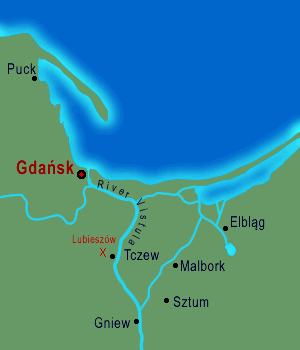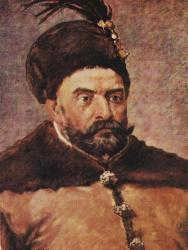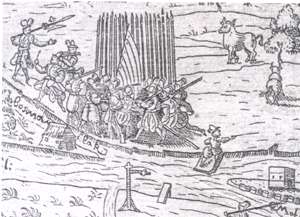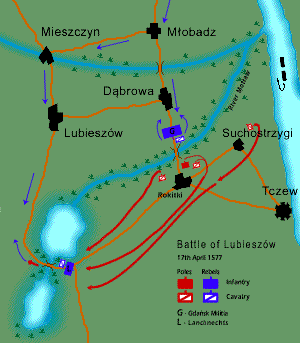|

Battles
Home Page
Gdansk
Rebellion 1576 to 1577
|
|
War with the Gdansk Rebels 1576-78
Introduction
 Already
in 1570 Gdansk had defied the Commission which regulated relations
between Poland and its largest town. In the 1576 election of the
King, Gdansk supported the Hapsburg candidate, so when Stephen Bathory
was elected the port rebelled. Bathory placed a ban an Gdansk transfering
all trade to Elbing. When resistance continued, with rioters burning
the Abbey of Oliwa, Bathory attacked by force. Already
in 1570 Gdansk had defied the Commission which regulated relations
between Poland and its largest town. In the 1576 election of the
King, Gdansk supported the Hapsburg candidate, so when Stephen Bathory
was elected the port rebelled. Bathory placed a ban an Gdansk transfering
all trade to Elbing. When resistance continued, with rioters burning
the Abbey of Oliwa, Bathory attacked by force.
At this time Gdansk was surrounded by a strong wall
originally built in the Middle Ages and strengthened in the Sixteenth
Century with earthworks. Two new walled bastions were constructed,
while the fortifications were supplemented with many dams and sluices
which made the flooding of various areas possible. The entrance
to the port was protected by a strong fort - called Latarnia. Also
the town could hire or muster over 10,000 men.
In August 1576 Bathory led 2,000 men to Malbork (Marienburg),
from there Polish units ravaged the area surrounding Gdansk, capturing
Grabina and Glowa, two stategically important towns, thereby blockading
the port from the east and the south. The King left the army under
the command of Hetman Jan Zborowski, most of the forces were stationed
at Tczew (Dirschau). In the west the main base was at Puck, where
there was a mercenary force led by Ernest Weyhera, and also some
Polish privateer ships which fought the Gdansk and Danish fleets.
 During
winter both sides restricted their activities to small raids, while
in the Spring the thaw stopped all movement. During this time the
Gdansk magnates hired a group of German mercenaries, to be commanded
by a well known Condottiere, Hans Wickelbruch Yon Koln. In April
1577 Wickelbruch decided to attack Zborowski's army at Tczew and
destroy it before new forces led,by the King could arrive. During
winter both sides restricted their activities to small raids, while
in the Spring the thaw stopped all movement. During this time the
Gdansk magnates hired a group of German mercenaries, to be commanded
by a well known Condottiere, Hans Wickelbruch Yon Koln. In April
1577 Wickelbruch decided to attack Zborowski's army at Tczew and
destroy it before new forces led,by the King could arrive.
Towards Tczew Wickelbruch moved 3,100 Lansknechts,
400 Reiters, 400 town horse and 6,000-8,000 town militia, with 7
cannons and 30 ultra light cannons mounted on wagons. He aimed to
cross the river Motlawa (Mottlau) and attack Tczew, while 210 men
in boats attacked the town from the river. On hearing about the
rebels movement Zborowski, with 1,350 cavalry, 1,050 infantry and
a few cannons, left Tczew to meet them. 100 men remained at Tczew
to help the inhabitants in its defence.
 The
river Motlawa was swollen from the thaw, with very marshy banks
and could only be crossed at a few places. The closest crossing
to Tczew was at Rokitki, a second was south west of the first between
the Lubieszow lakes. Zborowski formed his forces at the Rokitki
crossing sending scout units to the second crossing and towards
the sailing boats on the Vistula. The
river Motlawa was swollen from the thaw, with very marshy banks
and could only be crossed at a few places. The closest crossing
to Tczew was at Rokitki, a second was south west of the first between
the Lubieszow lakes. Zborowski formed his forces at the Rokitki
crossing sending scout units to the second crossing and towards
the sailing boats on the Vistula.
Wickelbruch sent the militia and 200 cavalry to Rokitki
to occupy the Polish forces there, while he proceeded with the rest
of his force to the second crossing at Lubieszow hoping to outflank
the Poles. The Polish scouts informed Zborowski of Wickelbruch's
arrival, but the two standards of cavalry the Hetman sent arrived
too late to stop the enemy crossing and was to weak to remove them,
especially as they were already strengthening their positions.
 Zborowski
ordered the destruction of the bridge at Rokitki, which made crossing
there impossible, and sent all his forces to the lakes. 600 Hungarians
attacked the enemy initially crouching to avoid the enemy fire and
then charging to make contact, cavalry supported their left flank.
The enemy cannons were taken, after which they were used in a brief
fire fight in which the Poles (and Hungarians) suffered least casualties.
Wickelbruch ordered the Lansknechts to attack and they were met
by the Hungarian and Polish infantry, who had dropped their guns
and charged the pikemen with their sabres. With the Lansknechts
halted momentarily, two standards of hussars charged them in the
flank. The Lansknechts broke and with their main force fleeing the
remainder of the rebel troops followed suit pouring through the
narrow crossing between the lakes. Their pursuit by the Polish cavalry
reached as far as Gdansk. The Gdansk militia retreated from Rokitki
and the sailboats on the Vistula turned back. Zborowski
ordered the destruction of the bridge at Rokitki, which made crossing
there impossible, and sent all his forces to the lakes. 600 Hungarians
attacked the enemy initially crouching to avoid the enemy fire and
then charging to make contact, cavalry supported their left flank.
The enemy cannons were taken, after which they were used in a brief
fire fight in which the Poles (and Hungarians) suffered least casualties.
Wickelbruch ordered the Lansknechts to attack and they were met
by the Hungarian and Polish infantry, who had dropped their guns
and charged the pikemen with their sabres. With the Lansknechts
halted momentarily, two standards of hussars charged them in the
flank. The Lansknechts broke and with their main force fleeing the
remainder of the rebel troops followed suit pouring through the
narrow crossing between the lakes. Their pursuit by the Polish cavalry
reached as far as Gdansk. The Gdansk militia retreated from Rokitki
and the sailboats on the Vistula turned back.
The enemy lost 4,420 dead and about 5,000 taken prisoner
Polish losses were 188 of these 58 dead.
The superb victory at Lubieszow (17 April) was due
both to the excellent leadership and bravery of the Polish forces,
equally cavalry as infantry. Zborowski kept his forces together
up until the very end, separating only small units for scouting
purposes. As soon as he realised where the main attack would come
from he moved all his forces there. The first line of his forces
stopped the enemy attack, and a reserve of heavy cavalry sealed
the victory.
The victory however could not be fully taken advantage
of, only in June did the King bring new forces. The 7,000 cavalry,
4,000 infantry and 22 guns were concentrated at Tczew and used to
attack Gdansk, whose forces had been strengthened with around 10,000
new mercenaries. A raid by the rebels on 3rd July destroyed the
Polish camp at Latarnia including two thirds of the artillery, and
forced them to move to Glowa. The Polish attacks on Gdansk failed,
mainly due to the lack of artillery and the strength of the enemy.
In September Bathory began withdrawing his forces
from Gdansk, he was preparing for a much more important war, against
Muscovy. The Gdansk magnates had suffered a great deal from the
blockade, especially because of lack of trade. So both sides sued
for peace, Bathory received 200,000 zloty, but Gdansk retained much
of its freedom from Polish control. .
1
|
|

Page 1
|

![]()